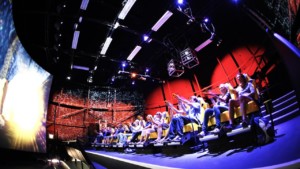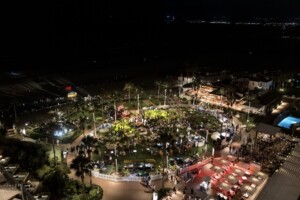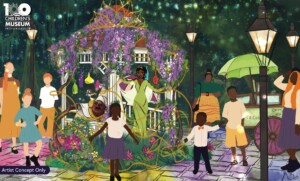TRIOTECH, creator of the most technologically-advanced immersive and interactive media-based attractions for the entertainment and edutainment markets, has installations in over 40 countries across the world.
Blooloop spoke with Ernest Yale, its visionary founder and CEO.
"Instead of going to class I was going to the computer lab"
Yale’s first exposure to video games was in the 1980s, when he was around twelve. He was unable to convince his parents to let him have video games at home so, when computers arrived at his school, he essentially took up residence in the computer lab during lunch times and after hours: “They kicked me out when the school closed, basically.”
He was fascinated by the technology and learned very quickly – as he points out, the teachers “hadn’t a clue back then” – devouring books on machine language, programming, graphics – and applying what he learned by re-programming versions of the games he had seen advertised: Pacman; Space Invaders and so on, on the Commodore computer.
“The interesting thing is that I never really liked playing with the games back then – I preferred developing and tweaking them; changing them a bit. This was all in a very raw, low-resolution, text-mode format. I didn’t know then that an actual games industry existed. But, a lot of the other students played my games and gave me feedback and complimented me and asked for more, and I saw I could do something that other people would play. That’s how I started.”
This was long before the days of networked games but Yale watched how people in the lab played his different games, discussing and comparing scores, and saw it as a way to bring people together.
“I had an arrangement with the teachers because I was pretty good at math and things: instead of going to class I was going to the computer lab, and programming some software that the teacher could use with the other kids.”
“I don’t learn in a traditional way…I learn by myself, and take my own path."
After a few years, he went on to study at the Ecole Polytechnique in Montreal. By this time he was aware that people were being paid to develop video games in places like California and the UK. However, this was 1989, and Montreal was not like it is today, an important video game industry centre.
His course was very engineering based, and while he was adept at maths, software was his metier. He switched to another university where there were more classes on software engineering.
However, the classes were primarily theoretical and Yale, who learned through practical application, found himself skipping classes before he had completed his Bachelor’s Degree. To keep up, he developed his own computer software to practise the machine language.
“I remember doing a clone of a very popular puzzle video game… Back then, before the internet, there were what we call BBSs [built-in board systems], and I sent off my game, and it was shared around the world, in the UK and Europe. People uploaded the game and exchanged it for free. It was a shareware game, and the characteristic of the game was you could play a game similar to Tetris, by connecting and playing over the phone, and you could also play split screen, with two players playing on the same screen. I really liked that. Before the internet, there was scope for interaction.”
In 1991 the software was among the top three pieces of shareware software downloaded around the world, and Number 1 in the games charts (PC Magazine).
“But this was before I knew it was an industry as such in which one could make money. I was receiving these envelopes with $5 inside from all around the world. I remember soldiers deployed on field operations had these early laptops, on which they were playing my game. They sent me a letter. I was really fascinated by people around the world using the same software.”
"I had my own vision about doing video games with an arcade game"
While he was still doing his degree, one of his tutors, impressed by his ability, hired him to work in a multi-media company as his summer job.

For the first time he saw an application of multi-media software which was sold to the public on CD Roms. This was in the mid-nineties so the internet was starting to grow but, Yale says, “I was not much exposed to the internet.”
He discovered he had a talent for multi-media software and had some fresh ideas of his own. Thus, the following year, he and Jean-Francois D’Arrisso, a friend he met at university who today serves as Triotech’s Director of R&D and Chief Architect, started their own multi-media software consultant company.
In the meantime, he was completing his degree.
“I don’t learn in a traditional way when in school. I learn by myself, and take my own path. But I knew it was important for me to finish my Bachelor’s degree, so I finished it, and in the meantime we were doing multi-media software for customers.
I had my own vision about doing video games with an arcade game. I was really fascinated by the fact you could build a machine, put software inside, connect a screen and people would play it. Again, this was a network game – a kind of first person shooter, but networked. That has always been really important to me: that more than one person played together.”
"I never knew the limits, I never thought we shouldn't try this"
In 1999, Yale made the decision to stop the multi-media company, and Triotech was founded.
“I was one of the founders of Triotech. My area of responsibilities was the games and developing the software. From the beginning, even in the agreement we had, was the notion that we would develop our own games, our own software, and create our own thing. This was important to me; the integration angle."
Triotech first showed a coin-op machine at IAAPA in 1999.
“That was how really we started in the amusement industry – that first year we didn’t have any money, so we had to drive from Montreal to Atlanta, to IAAPA, a 20 hour drive. We couldn’t even afford the airplane back then. Nowadays, we have a 4000 sq ft booth, and back then we probably had a 10 by 20 ft booth in the corner showing one coin-op machine.”
Yale was fascinated by the amusement industry.
“I thought it was incredible… I never thought we could be one of the companies that innovates in the industry and become one of the major players. We just thought we might sell a few machines… But… While I never thought we’d be necessarily major players, I always had the ambition of doing it. I never knew the limits. I never thought, we shouldn’t try this. It was alwaysl, let’s do it like this, or, let’s try to make a new game, or change the game. I didn’t expect us necessarily to succeed but I knew the direction in which we had to go.”
Triotech began to grow gradually, first introducing motion in their two-person arcade simulators, then linking their video games, then introducing racing games.
Five or six years ago, major change began to happen with the introduction of Triotech’s small 4D theatres.
“We had the best 4D theatres. Everybody was telling us we had the best simulators at IAPPA – even the staff from other vendors and employees who worked there and so on. They always tried all the rides and would tell us: You guys have the best rides!”
Triotech was constantly pushing the envelope. There were numerous companies doing 4D, but Triotech’s motion was the most intense and realistic;  there was individual seating:
there was individual seating:
“I really wanted us to have our own software. So, we created a division within the company which had a studio where we created our own movies, because I felt that there was a lack of good content coming out compared to, let’s say, Disney rides and Universal rides. So we created our own rides with what we learned from the experience and feedback that people were giving us.”
"When we do a large ride it has to be as good as Disney"
One of the first rides Triotech produced in this way was Canyon Coaster, a roller coaster set in the Grand Canyon, and still one of the best sellers, featuring a dizzying drop down the canyon and a landing in underground tunnels – all content, as Yale points out, that has been done before, but Triotech pushed it to its limits, improving the graphics; working on better motion and integration of effects.
As Yale put it: “Really, one of the things we excel at is to use technologies that exist; things that have been invented – but we push them to the next level and we make sure that we have the best implementation and integration of that technology.”
Yale remains faithful to the interactive games that were his first love, which was why, in 2010, Triotech showed their interactive theatre at the Asian IAAPA expo in Kuala Lumpur. Others had done something with interactive theatre, but Triotech’s innovation was in a different league. It was the most advanced in the industry – the fastest, most responsive system with zero compromise on technology.
“… A lot of people have told us, ‘your attractions are the best – I want them – but the price is higher than some of the foreign (for example) attractions.’ But, the technology is something that we decided we would never compromise on. We want to do the best attractions. For us this is defined by the user experience. I've said before that when we do a large ride it has to be as good as the best in the industry. People laughed, but that’s really what I think. Even though the budgets are smaller, if we’re smart about it, why can’t we do something that’s unique and, in its own way, is something new, that no-one has done exactly like this before… And we really judge it by people coming out of the ride and saying, this is the best. It’s aspirational. Disney and Universal are the best in the industry, and we have the aspiration of delivering as good an experience to Mrs and Mr Anybody, and why not?”
Advances in technology have made it possible to deliver impressive and ground-breaking experiences at an affordable price.
“We can provide a top-of-the-line user experience at a fraction of the cost that it used to be in, say, the 90s or the early 2000s.”
Yale adds: “We saw that a few companies were making products where you could interact on the screen, and I really was not satisfied that this had been pushed to the limit. I I thought we could do better, basically. That’s always the start if you’re an entrepreneur: you think, well, maybe I can do better. And, it’s not arrogance, it’s saying, I have a certain vision, and let’s try this and maybe we can succeed.”

"I think Triotech is the only company that does complete media-based attractions from start to finish"
Triotech focused on its interactive theatre. It took around two years of showing it at IAAPA to sell the first unit.
“It takes a lot of time and money to start from an idea and deliver a product – like the interactive theatre: we spent millions of dollars just promoting it, travelling around the world, showing it to people, getting feedback and then developing content for it. It’s like the chicken and the egg – you can bring this new technology but then you need the content, and content developers will not invest in making content because they feel that the install base is too small. We decided we would do the content: hire the graphic artist and creative directors; the programmers, and make these attractions – a bit like Disney has done, and Universal: they’re the only ones who have the muscle to do everything in-house and create an attraction from scratch.
I think Triotech is the only company that does complete media-based attractions from start to finish – in the sense that we design it; we have a factory; we build it; we do the software; we do the content; we have the sales team; we have the installation team.”
Having sold the first unit, they envisaged that the product would slowly grow, steadily gaining momentum. Instead, the sales exceeded all expectations, to the point that interactive dark rides now account for the majority of Triotech’s sales. This year, over 13.5 million people across the world will have been through a Triotech experience.
As a comparison, this is akin, in terms of numbers, to the number of people who will see a Cirque du Soleil show during 2015.
“It’s not the same, but as the Cirque is also from Montreal we use it as a comparison.”
Triotech is now seen as a front-runner in the industry.
Yale comments: “When you think I started doing small games on the Commodore in the computer lab… and then you think about more than 13 million people and growing every year doing your attraction, it’s kind of mind boggling. We’re really proud of having achieved that, but, at the same time, it’s a responsibility.”
He adds, “…the growth of our company is our research and development department, and this is how we will grow the company: exactly like we did with the interactive technology – creating new and exciting attractions by identifying and investing in new technologies some of which already exist: someone has invented the technologies, but we put them together for a group of twenty people to enjoy at the same time."
Adaptability is a quality that increases the saleability of Triotech’s attractions.
Triotech put their interactive technology on the interactive dark ride/coaster for Cedar Fair in Toronto – the attraction for which they won the the Impact Award and the Brass Ring Award for Best New Product in the Major Theme/Attraction Park Ride category at IAAPA 2014 – the ride evolved over time and its content was changed according to the occasion. For instance, last year during the Hallowe’en season, the content was changed so it became a zombie ride. The whole interactive dark ride/roller coaster re-imagined to be, effectively, a completely different ride:
“…something completely new that changes the business model..” as Yale commented.

The capacity to refresh content is something particularly relevant for small parks to whom a roller coaster/interactive dark ride is a major outlay, and to local parks where the customer base may return regularly over the course of a year: visitors can experience different rides on the same equipment at different times.
The momentous change that Triotech brings to the industry lies in bringing impressive experiences to the users at a relatively low investment level for the parks, and in offering the capacity to change the content, thus offering, effectively, multiple rides on the same equipment.
“ …it’s the same physical layout, but all of a sudden the content has changed; there’s a new story.”

"The key is never to stop innovating; never to take things for granted."
The fact that the rides are interactive means that the user is no longer a passive passenger, but a protagonist. As Yale points out, “In 2015 people are used to clicking, touching and participating – they want to be involved, not spectators. And that’s what Triotech is bringing.”
He concludes: “There’s a bright future, and we’re really focused on that bright future.
The key is never to stop innovating; never to take things for granted, and always be attentive to what others are doing, because the ideas are all out there: people have the answers, but sometimes you need a company or a group of people to bring all these things together and make them move forward; to take those ideas and create a final product.
I have a feeling that things are just starting; that there are going to be a lot of changes in local amusement parks and that Triotech will be one of the companies that pushes the industry forward.”
.jpg)















